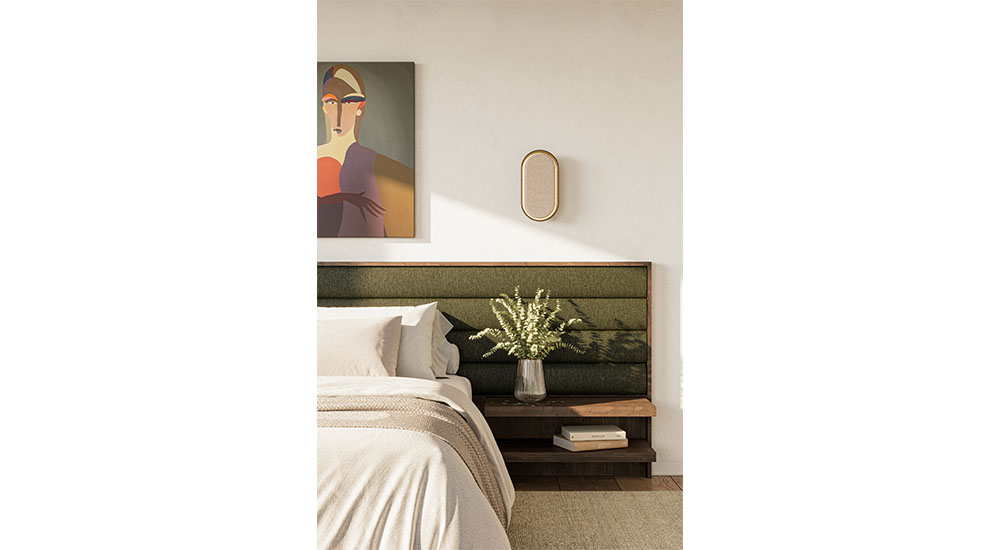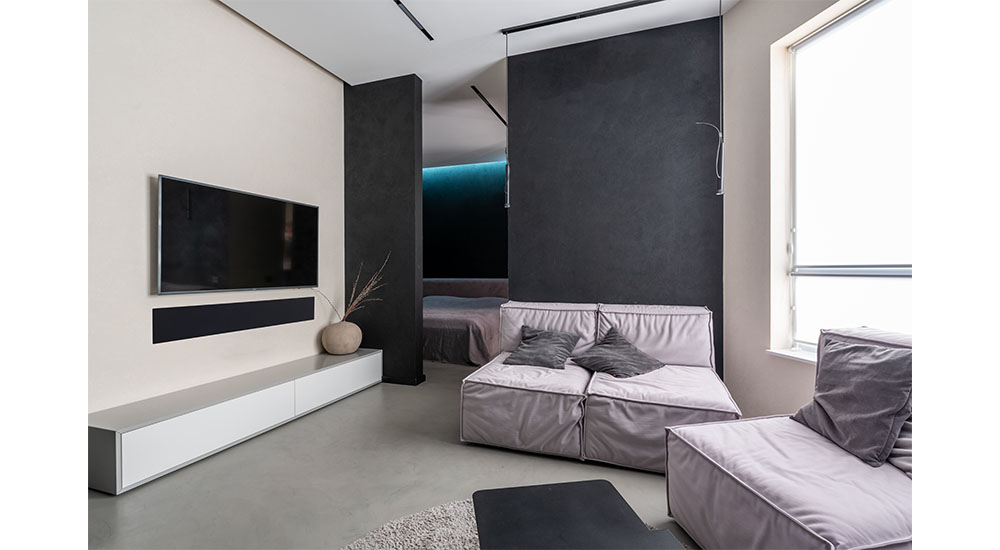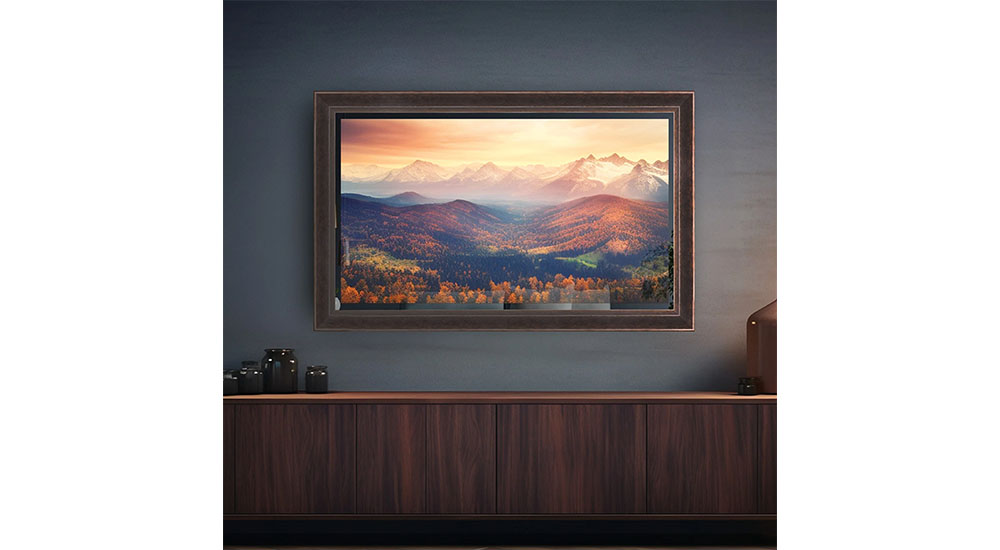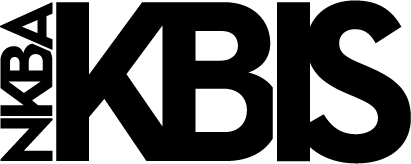Few things are more jarring to a design than unsightly technology, or even visible technology at all. Especially in today’s culture where smart phones, cameras and wearable tech seem to populate every moment, homeowners are looking for spaces that reduce the visible shock of smart home tech, without detracting from its benefits.
Above: Seura’s new standard TV mirrors feature today’s most popular finishes and boast a 70 percent increase in brightness, alongside a smart OS for access to streaming services and whole home control control. Available now with a new remote control with Air Mouse Technology, Framed TV Mirrors are ideal for living rooms and bedrooms, while Vanity TV Mirrors are designed for bathrooms, salons and spas.
“The key to incorporating tech into our projects is that it should not impact your design but enhance it,” said designer Ebony Stephenson, CLIPP, CAPS, principal of Designs by Ebony in Newport News, Va. “Don’t be afraid to use it.”
The Potential of Technology
Smart home technology involves much more than screens, and as rooms evolve into more multifunctional spaces, TVs are no longer the designated focal point. From motorized lifts that allow screens to emerge from countertops or cabinets, to mirrors with integrated displays, these solutions offer a way to enjoy entertainment without sacrificing aesthetics.

Designed in collaboration with Mera Studio Architects, Leon’s new Mera Sound Sconce blends high-performance audio with dimmable LED lighting, and artisan-inspired craftsmanship. Available in three coordinating colorways inspired by natural materials, Mera Sound Sconce is available in single units, pairs or bundled with the Sonos Amp.
Likewise, in-wall and in-ceiling speakers provide an elegant solution for listening to integrated music without bulky speakers. Ultra-slim, nearly invisible speaker systems can seamlessly hide in walls or ceilings, providing high-quality sound without disrupting the design flow. Meanwhile, touchless panels and voice-activated systems, as well as motion-sensing technology, make controlled lighting more effective in homes.
However, these products are not one-size-fits-all; what smart devices, controls and appliances to incorporate is always very personal.
Getting Rid of Electronic Clutter
What everyone can agree on is the ugliness of electronic clutter. According to integrator Michael Daugherty, this includes common mistakes like visible security alarm sensors on doors and windows and clusters of control panels or light switches. There should never be more than two wall mounted devices in an entry, and light switches should never be more than two or three gangs wide.
“A simple touchscreen interface or iPad is all that’s really needed to operate a home,” said Daugherty.

Access Networks’ Wi-Fi 6 access points deliver high Wi-Fi performance and consistent coverage. It is purposefully developed to enable the network to function at full capacity, even when numerous Wi-Fi compatible devices – such as smartphones, laptops, media streamers and doorbells – are connected. Wi-Fi 6 also extends the battery life in mobile devices and includes built-in functionality to avoid interference from other nearby Wi-Fi networks.
Cable management systems like cord organizers, under-desk trays or wall-mounted channels offer options to bundle and hide cords neatly. Consider built-in solutions with recessed compartments that can seamlessly house TVs, sound systems and charging stations into walls or ceilings. Drawers with built-in charging stations, integrated into kitchen islands or bathroom vanities, keep devices hidden while ensuring they’re always charged and ready for use.
“The exact location of anything that’s visible should be site verified prior to installation,” said Daugherty, adding that designers should insist on a reflected ceiling plan so light fixtures and ceiling speakers have linear cohesion. “Designers should make sure that aesthetic decisions are not left to the whims of the integrator or alarm installer.”
The Importance of Working with an Integrator
Instead working closely with an integrator is integral for correctly using the right products in the right way. Integrators know how the space’s materials might impact the Wi-Fi signal performance; building materials such as concrete, tile, stone, metal and brick can interfere with the Wi-Fi and make it difficult for signals to pass through. They can also educate you and the client how to use their technology to its full advantage.

The Model L-90 from Nexus 21 is a quiet solution for concealing large TV screens up to 90 inches, raising them in just 17 seconds while maintaining an elegant design and near-silent operation.
“For my own project, connecting my designer with a custom integrator early on ensured the smooth integration of these technologies,” said Andy Orozco, senior vice president of custom integration at Nationwide Marketing Group. “These experts handle the wiring, system integration and ensure both performance and a clean, cohesive look that complements the space. This early involvement helps avoid technical issues or costly redesigns later.”
Sometimes this is easier said than done. Stephenson explained how one of her biggest hurdles with new technology is convincing her installers to even put it in. Especially as the labor force ages, some installers hesitate to learn new tech and methods. She has sometimes used a different installer or integrator who is up to date and willing to use the product, rather than someone who will complain the whole time.

WALL-SMART has launched WALL-SMART Sonos Soundbar Wall Mounts, a new line of flush wall mounts for Sonos’ popular Beam and Arc Soundbars. Traditionally, soundbars are set inside or on top of furniture. The line includes wall mounts that enable the Sonos Beam and Sonos Arc to be recessed within wall surfaces and gives designers and integrators the ability to hide speakers.
Despite the difficulties, designers continuing to learn and encourage technology in their projects will see good results. Attending trade shows, working with professional integrators and attending webinars and meetings about the latest technology will help designers grow.
“Some designers are afraid to use new technology because of the learning curve,” added Stephenson. “But just like when you get a new smartphone or a newer model car, you must take some time to learn the new system and get used to it. It is the same with smart home technology.”









